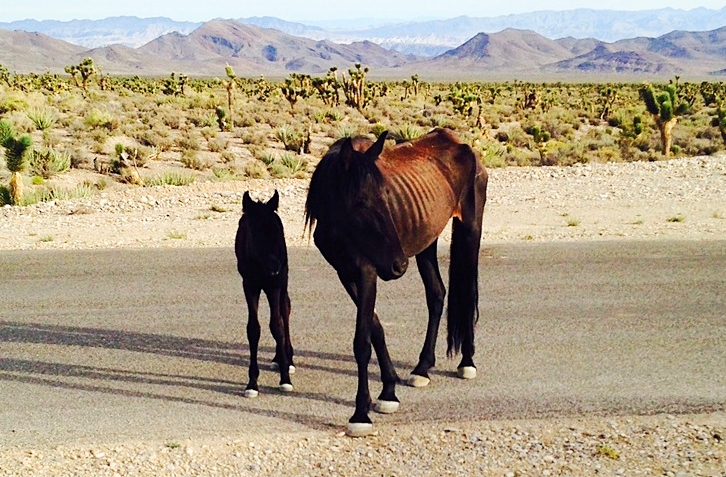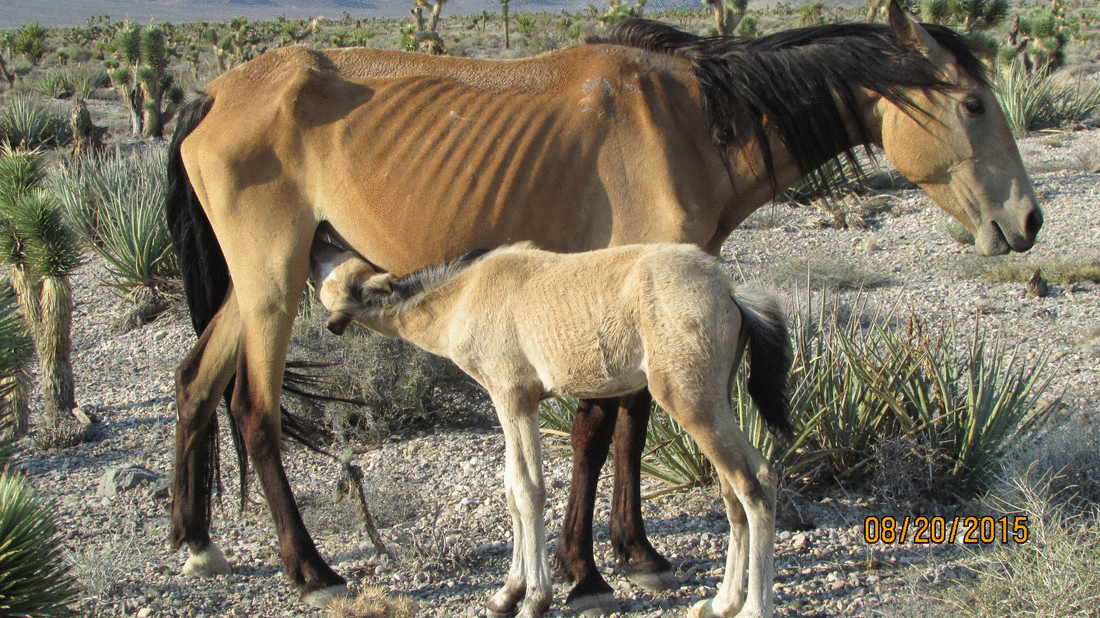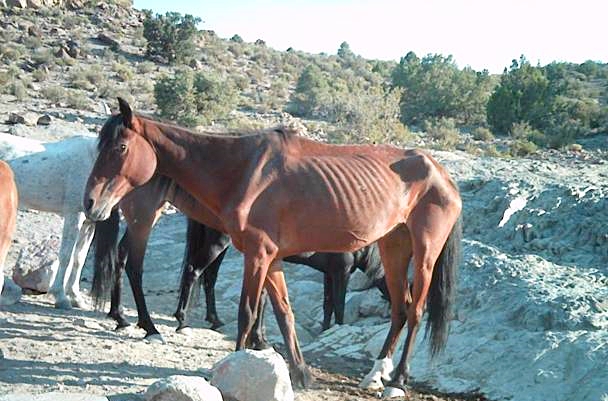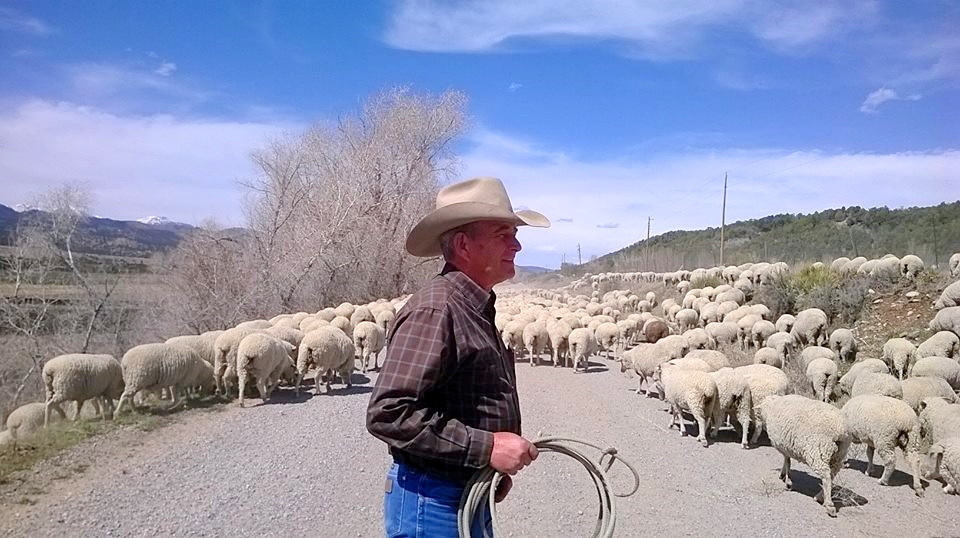Horses and burros gathered by the BLM are held in holding facilities. A small number of them are adopted to private caretakers. The vast majority remain in these facilities, cared for by the BLM. These facilities currently house over 46,000 horses and burros, costing the American taxpayer nearly $50 million per year.

Counties in Western states including Nevada, Utah, Arizona, New Mexico, and Colorado, are contending with out-of-control horse populations, which the Bureau of Land Management (BLM), due to ideologically-driven policies and fear of bad press, has failed to properly manage.
These ‘iconic’ animals are a favored fund-raising mechanism among animal rights groups, including the American Society for the Prevention of Cruelty to Animals (ASPCA) and the United States Humane Society, and the BLM’s attempts to control their populations according to federal law, have been met with hysterical outcries and lawsuits. But this disaster is growing in only one direction, and is resulting–and will continue to result–in suffering and starving animals, degraded rangelands, harm to wildlife and plant populations, conflicts with ranchers, farmers and landowners, and economically strapped communities.
It’s time for America to call out the tactics of the ASPCA and the Humane Society, and others like them, and expose the disaster, caused in part, by their ‘save the wild horses’ fund raising efforts. Please review these troubling facts and encourage your leaders to address the wild horse and burro crisis with urgency and soberness.

The horses and burros that roam freely across areas of western North America and along parts of the Atlantic coast are feral animals, and are not native to North America. These animals are descended from domesticated breeds brought to North America from Europe. Yes, they are iconic and beloved by some, but damage crucial wildlife habitat and require improved and sustainable management practices. The population and impact of these horses and burros can be difficult to control, amplifying their effects on native habitat and wildlife. In some cases, current management of horses and burros and their effects diverts resources (human and financial) from management of native species and habitat.
- Wild horses and burros are to be managed according to the Wild and Free-Roaming Horse & Burro Act of 1971, which specifies where wild horses and burros can occupy public lands, and that they shall be managed in a manner that produces a thriving natural ecological balance. In addition, the Bureau of Land Management (BLM) and U.S. Forest Service (USFS) are required by law to manage and balance multiple uses of public lands, including wildlife, horses, and cattle grazing.
- Wild horses and burros are managed by federal law, and are only authorized to be on Bureau of Land Management (BLM) and U.S. Forest Service (USFS) lands.
- BLM estimates their lands contain over 67,000 horses and burros as of May 1, 2016.
- USFS provides a rough estimate of approximately 10,000 horses and burros on their lands.
- Free-roaming horses and burros are also present on other federal, state, and tribal lands – however, these animals are not “wild and free-roaming” as defined in the federal law, and therefore are managed differently. The total number of free-roaming horses in the United States is likely in the hundreds of thousands.
- BLM lands where horses and burros should be managed can only support 27,000 individuals in balance with the ecosystem and other uses of the range. This means there are over 40,000 excess horses and burros, degrading our rangelands.
- Wild horse and burro populations have a demonstrated ability to grow at 18-20% per year. This means their populations double every 4-5 years without proper management actions.
- BLM currently uses a mixture of gathering and fertility control options to manage populations. However, these actions are not currently being used to the extent necessary to stop the growth of the horse and burro population, and our rangelands continue to be deteriorated.
- Horses and burros gathered by the BLM are held in holding facilities. A small number of them are adopted to private caretakers. The vast majority remain in these facilities, cared for by the BLM. These facilities currently house over 46,000 horses and burros, costing the American taxpayer nearly $50 million per year.
- Fertility programs only slow growth of the herds, and do not address the wild horse overpopulation problem.
- Nevada alone has over 40,000 horses on its rangelands.
- The appropriate number of horses for the Pancake Horse Management Area (HMA) in Nevada is 240-493 horses, it’s spring 2016 spring population was 1,800 horses.
- By late summer this same HMA will have over 2,100 horses with foals—a population of 426% of the manageable number.
- Captive wild horses will cost tax payers over $1 billion cumulatively by 2030 if BLM maintains its current management practices.
- The estimated cost of lost opportunity to rural counties is $1,900 per horse per year.
- If BLM maintains current management practices the number of wild horses in Colorado will double to 150,000 in 4 years, and double again to 300,000 in another four years.
- Failed federal management of wild horse and burro populations have devastated state and private lands leading to:
- Decreased crop yields
- Increase in invasive weeds and grasses
- Devaluation in land values
- The BLM breaks federal law by failing to act in accordance to existing legislation governing wild horse and burro populations.
- § 1333(b)(2) REMOVAL OF EXCESS ANIMALS instructs: “When overpopulation exists and action is necessary to remove excess animals, then Secretary shall immediately remove wild horses and burros”—THE BLM ALLOWS MANY TO ROAM FREELY ON RANGELANDS
- “Old, sick or lame animals to be destroyed in the most humane manner possible.” Under pressure from animal rights groups, BLM rarely euthanizes animals, even those in extremely poor condition.
- “Any additional excess wild horses and burros to be humanely captured and removed for private maintenance” The BLM keeps the animals in holding facilities and the animals are sold or adopted only thorough a cumbersome process with very strict limitations.
19. Legally, wild horses and burros more than ten years can be sold without limitation, but hysteria over the commercial sale and slaughter of horses has impeded and often stopped this process.

Free Range Report



This BLM program is a travesty. Anybody who thinks you can confine 46K+ large grazing animals indefinitely is crazy, to say the least. All a horse does is eat. Anybody who has raised them for ranch use knows that. These animals should be slaughtered forthwith and the meat distributed to hungry people all over this country. Many countries eat horse meat; I have eaten horse meat; it is nutritious, low in fat, and compared to other types of meat readily consumed by the American public it would be cheap to buy. Horse steak is a lot like a good elk steak – delicious.
Slaughter them for food and by products. Any other use of these animals is utter insanity.
Well said!!!!!! Amen!
You are sick and you don’t know all the facts. Eating horse meat is a travesty. We also have an excess of dogs so I suppose you would advocate eating dog meat and selling it off to starving people. And feeding a horse that’s been shot up with PZP and vaccines to humans is immoral and should be a crime. There is a humane way to solve this issue. It’s called sterilization and not necessary to use toxins like PZP. The BLM GENERATES 5 BILLIONS DOLLARS IN REVENUE by their own admission….go fact check buddy. THESE HORSES ARE NOT FEEDING OFF OF TAXPAYER MONEY BUT RATHER AMERICANS ARE BEING MILKED BY THEIR GOVERNMENT. THere’s plenty of money to resolve this problem humanely.
Here’s an excerpt from an article that mentions this but you can find it with little research into BLM finances, Go to their website if you know how to use a computer.
http://www.theblaze.com/contributions/the-hugely-profitable-bureau-of-land-management-3/
“in Fiscal Year 2012, nearly $5 billion will be generated by activities on BLM-managed lands, including an estimated $4.3 billion from onshore oil and gas development, with about half of those revenues going to the states where the mineral leasing occurred.”
Let’s think about that for a moment: $5 billion dollars in revenue, nearly half of that from coal, on $1 billion dollars in operating costs. A profit margin that far exceeds those of many of the most successful companies in history. And what about the half that doesn’t go back to the states?
Just where is the department and BLM spending that $1.5 billion in net profit?
Why is President Obama requesting a $1.1 billion dollar taxpayer funded 2015 appropriation for an agency where revenues are five times operating costs?
These are questions every member of Congress should be asking, and to which every American should be demanding answers.
Should any United States government agency be in the business of controlling 245 million acres of public lands and 700 million acres of subsurface mineral estate, generating a $4 billion dollar gross annual profit, with 270 armed federal rangers and special agents making sure it all runs smoothly.
America needs to find its soul and wake the hell up.
I agree with your vitriol concerning the federal government, in part, but like all socialists you cloud and fail to address the core issue – excess horses – with hand wringing crap.
Let me guess, you are a male – I guess Taylor is a male name – between 25 and 40, still living with mommy and daddy, who majored in Anazai Basket technology or Gender Equality, if you even received any higher education, you know essentially nothing about the subject – again, excess horses – and you voted for the Negro, Muslim, communist that we just got rid of.
I stand by my comments on the 46K excess horses and donkeys. Unlike you, I know lots about horses. The 46K must be eliminated. Their meat is very tasty and nutritious – I’ve never eaten a donkey, because I had good horse meat to eat. And you are absolutely right about dog meat, it’s good too. If you had ever left the safety and comfort of mommy and daddy’s place to venture anywhere in the Orient, especially Vietnam or the Philippines, you would know how good it is, because they eat dogs all the time.
People like you are the enemy; I don’t care what you think about anything. Everyday more and more of the rest of us are coming to realize that fact. Prove my contention with one of your hand wringing, canned responses.
Eating excess animals wheather they be dogs or cats or horses would not be a problem if their lives were ended humanely. Infact, it might be time to change the taboo around consuming them. But even if people don’t want to consume horse meat, sending the excess horses to American slaughter houses and using that meat to feed zoo animals is far kinder and far more practical than allowing those horses to slowly starve to death on the rangelands or holding thousands of them in captivity for the rest of their very long lifespan and if they’re slaughtered in America then we can ensure that humane slaughter practices are used. Your anger towards J.A. For his suggestion that we consume horse meat is illogical considering that it is misguided protests to BLM management practices and the bureau ‘s fear of bad press from misinformed animal activists groups that put our wild horses in this situation. Preventing the removal of a few has caused a great deal of suffering for these horses and the native wild life they cohabitate with and now more drastic measures are becoming more and more necessary.
Way to go, Rebecca, you get it. Animals for slaughter are always killed humanely in slaughter houses. It wouldn’t seem so to the limp-wristed among us, but you can rest assured that the animals in question never knew what hit them.
I have raised registered Quarters & Paints for 30 years. We no longer breed but horses are a part of our lives and we dearly love them and take the best care possible of them. the ones we have left are family.
On top of the economy taking a major dive, they shut down horse slaughter, worst thing you could have done. Slaughter regulates the horse market. If you don’t have slaughter you have abandoned, mistreated, starving animals. The best you can do is try to enforce laws that are as humane as possible about hauling, food, water, etc . . . and hauling to Canada or Mexico to be slaughtered is NOT humane.
We live in Minnesota, can you imagine if they did away with deer season? They would over populate to the point where they would be unhealthy, starve themselves out, take out farmers crops and damage a lot more cars.
What happened to the slaughter houses that were to be re-opened? I have no problem with people needing to save them as long as they put them in their own back yard & take good care of them. In order for them to survive in the wild, they need to be cut back. People need to do their best to be responsible breeders, that’s why I quit & my market was pretty much gone. With people racing & breeding Thoroughbreds (for just 1 example) you are always going to have an overflow of excess horses.
Encourage adoption programs too but reopen the slaughter houses.
I completely agree with your comments. I, too, raised horses for my own ranch use, selling the excess here and there over the many years. My family and I loved them like any other horse owner, but we were pragmatic about them – if they were not being used, or were not needed they had to be sold. In the case of old horses severely harmed by the severe winters of the mountain country of north central Colorado, I destroyed them myself – not an easy solution, but necessary.
The government is at that point now with the vast herd of horses and burros they are feeding with the people’s money. They must open processing plants and begin solving the problem that they have created. As I stated in my original comment it is utter insanity, given the cost of feed, not to mention the severe stresses that impoundment places on the animals, to consider any other course of action.
All i know is i live in canada and your horses being shipped here for slaughter has decimated our horse Industry we would be so happy to have ya all start your slaughter houses back up.
I completely agree, Rick. Here in the US, the government listens to the minority position – save all the horses and donkeys.
That position is untenable, as demonstrated by the 46K + equine welfare recipients and the costs associated with sustaining them.
The US slaughter houses must be reopened, and soon, before the numbers increase any further.
Intereating that you leave out a huge cog in the wheel of the WFRHBA as it has evolved. That is the Midwestern Congressional delegates and the ranchers who back them. Those same ranchers who are garnering that 50 million in Long Term Holding Contracts and have no interest in seeing that golden goose go away. When a Midwestern rancher is making more off his grazing leases than raising cattle he nor his representatives in congress are willing to see management succeed in reducing excess horses to the point that it would affect their income. Would you care to address that please?
Sure, Dee, in a few words, you are another individual who can’t stay focused on alleviating the problem – too damn many horses and donkeys – got it, now, Dee. The issue as presented has nothing to do with agricultural subsidies, the issue is TOO MANY horses and donkeys. They have to be slaughtered, that is the issue and topic of conversation
Does that clear it up, Dee?
I agree with this 100%
A couple of questions:
“The estimated cost of lost opportunity to rural counties is $1,900 per horse per year.” Please provide reference for this. Where does this number come from and who and how is it ascertained?
“If BLM maintains current management practices the number of wild horses in Colorado will double to 150,000 in 4 years, and double again to 300,000 in another four years.”
Colorado is probably the ONE state that is controlling wild horse populations through volunteer and NGO use of PZP. Spring Creek Basin is at zero growth and Sand Wash was gathered this year for the first time in a long time due to the use of PZP22, as is Little Book Cliffs. Efforts are being made to get a volunteer group organized for the Douglas herds. So not sure where those numbers are coming from in terms of Colorado. Would be nice if NV and WY would follow suit, instead of blocking every effort.
Correct. Colorado is in much better shape than Nevada or Utah when it comes to the horse herds.
I spent a couple of minutes reading and checking the facts.
Everything is clear and understandable. This one is of this sort.
Moreover, I like how the writer organized his ideas as well as the
visual part.